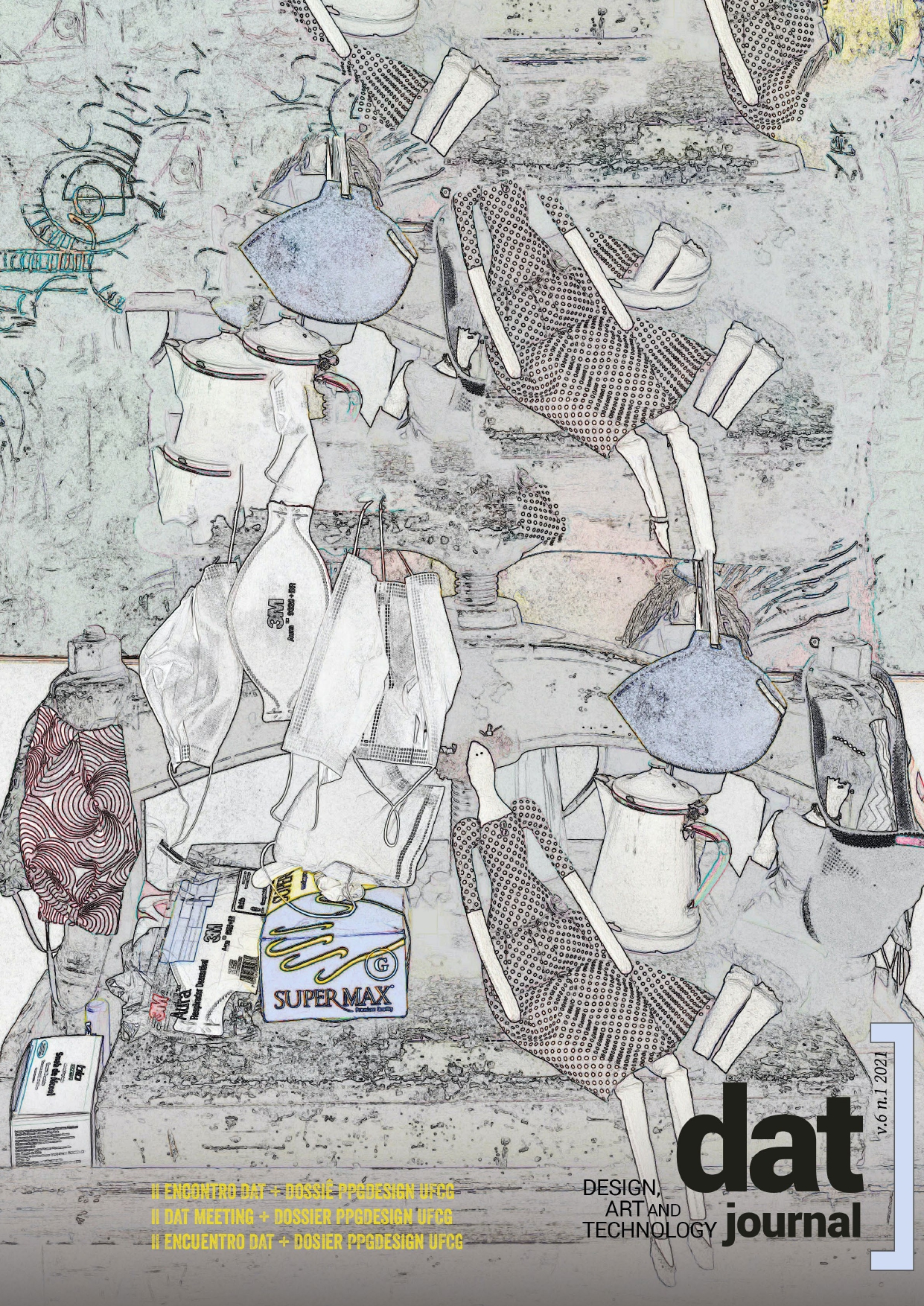Directrices de proyectos enfocados a afectos y memoria positiva orientados a la sustentabilidad
DOI:
https://doi.org/10.29147/dat.v6i1.339Palabras clave:
Diseño. Enseñando y aprendiendo. Proyecto. Sustentabilidad. AfectividadResumen
Estudiar, comprender y aplicar la sostenibilidad es fundamental en el contexto de la enseñanza y el aprendizaje relacionados con el diseño de productos. Es bien sabido que los principios del desarrollo sostenible pueden ayudar a reducir los impactos sobre el medio ambiente y promover cambios sociales, ambientales y económicos. Sin embargo, todavía se pasan por alto aspectos subjetivos relacionados con la sostenibilidad. En este trabajo se realizó una revisión bibliográfica sobre la relevancia de los vínculos afectivos, la sistematización de lineamientos de proyectos que pueden suscitar afectos y memoria positiva en la relación entre usuarios y artefactos, así como una investigación pre-experimental sobre la enseñanza y el aprendizaje en una disciplina de diseño de producto 2, en un curso de Diseño.
Descargas
Citas
ARGUIN, Claudel. Emotional durability is the new sustainability, 2010. Dissertação (Mestrado em Design) - Design Northumbria University, Newcastle, UK., 2010. Disponível em: https://issuu.com/claudel/docs/claudels_thesis Acesso em: 11 set. 2015.
APPADURAI, Arjun. Commodities and the politics of value. In: The social life of things. Commodities in Social Perspective. Cambridge: University Press, 1986.
BAUDRILLARD, Jean. A sociedade de consumo. Lisboa: Edições 70, 1995.
BORJESSON, Kristina. The affective sustainability of objects: a search for causal connections: studies of theory, processes and practice related to timelessness as a phenomenon. 2006. Tese (Doutorado em Design) - University of the Fine Arts London, Londres, 2006.
BROWN, Tim. Change by design: how design thinking transforms organizations and inspires innovation. New York: HarperCollins, 2009.
BÜRDEK, Bernhard. História, teoria e prática do design de produtos. São Paulo: Edgard Blucher, 2006.
CARDOSO, Rafael. Design para um mundo complexo. São Paulo: Cosac Naify, 2012.
CHAPMAN, Jonathan. Emotionally durable design: objects, experience, empathy. London: Earthscan, 2005.
CHAPMAN, Jonathan. Routledge Handbook of Sustainable Product Design. New York: Routledge, 2017.
CSIKSZENTMIHALYI, M.; ROCHBERG-HALTON, E. The meaning of things: domestic symbols and the self. Cambridge University Press: Cambridge, 1981.
DAMÁSIO, António. O Sentimento de Si: O corpo, a emoção e a neurobiologia da consciência. Mem Martins: Publicações Europa América, 2004.
DAMÁSIO, António. E o cérebro criou o homem. São Paulo: Companhia das Letras, 2011.
DESMET, Pieter. Designing emotions. 2002. Tese. (Doutorado em Design) - Delft University of Technology, Delft, The Netherlands, 2002. Disponível em: https://studiolab.ide.tudelft.nl/studiolab/desmet/files/2011/09/thesisdesigningemotions.pdf. Acesso em: 24 jun. 2017.
HAINES-GADD, Merryn; CHAPMAN, Jonathan; LLOYD, Peter; MASON, Jon; Aliakseyeu, Dzmitri. Emotional Durability Design Nine: A Tool for Product Longevity, 2018. In: Sustainability, v. 10, n. 6, p. 1948 Jun. 2018.
FRY, Tony. Reconstruções: ecologia, design, filosofia. São Paulo: Edusp; 2009.
FUAD-LUKE, Alastair. Design activism: beautiful strangeness for a sustainable world. Londres: Earthscan, 2009.
KAZAZIAN, Thierry. Haverá a idade das coisas leves: design e desenvolvimento sustentável. São Paulo: Editora Senac, 2005.
KOPYTOFF, Igor. The cultural biography of things: commoditization as process. In The social life of things. Commodities in social perspective. Cambridge: University Press, 1986.
KRIPPENDORFF, KLAUS. Propositions of human-centeredness: A philosophy for design. In:
DURLING, D; FRIEDMAN, K. (Eds.) Doctoral Education in Design: Foundations for future. Staffordshire: Staffordshire University Press, 2000. p. 55-63 KRIPPENDORFF, Klaus. The semantic turn: a new foundation for design. Boca Raton: Taylor & Francis, 2006.
KRUCKEN, Lia. Design e território: valorização de identidades e produtos locais. São Paulo: Studio Nobel, 2009.
KUBLER, George. A forma do tempo: observações sobre a história dos objetos. Lisboa: Vega, 1998.
MANZINI, Ezio; VEZZOLI, Carlo. O desenvolvimento de produtos sustentáveis. São Paulo: Editora da Universidade de São Paulo, 2002.
MANZINI, Ezio. Designing networks and metadesign. 2008. Disponível em: http://www.sustainableeveryday.net/manzini/. Acesso em: 25 fev. 2015.
MCDONAGH, Deana. Emotional sustainability. In: Routledge Handbook of Sustainable Product Design. New York: Taylor and Francis, 2017. p. 271-281.
PAPANEK, Victor. Design for the real world: human ecology and social change. Nova York: Phanteon Books, 1971.
PAPANEK, Vitor. The Green Imperative: Ecology and Ethics in design and Architecture. New York: Thames and Hudson Ldt, 1995.
PANTALEÃO, Lucas. Stuart Walker: a função estética sustentável: mediações entre arte, design e espiritualidade.Tese (Doutorado em Design) - Faculdade de Arquitetura Artes e Comunicação, Universidade Estadual Paulista, Bauru, 2017. Robbins, Stephen. Comportamento organizacional. São Paulo: Pearson Prentice Hall, 2005.
RUSSO, Beatriz. Shoes, cars and other love stories: investigating the experience of love for products. 2010.Tese.(Doutorado em Design) - Delft University of Technology, Delft, 2010. Sanders, E. B. N.; Stappers, P. J. Convivial Toolbox, Generative Research for the Front End of Design. Londres: BIS Publishers, 2014.
SOGUTI, Deniz; DESMET, Pieter; MERONI, Anna. Designing Emotions that last. Design United Exibition within Dutch Design Wee 2019. Disponível em: www.design-united.nl/critical-changes/designing-emotions-that-last. Acesso em: 23 março 2020.
SUDJIC, Deyan. A linguagem das coisas. Rio de Janeiro: Intrínseca, 2010.
THACKARA, Jonh. In The Bubble: Designing in a Complex World. Cambridge: The MIT Press, 2005.
Van Krieken, B.; Desmet, P.; Aliakseyeu, D.; Mason, J. A sneaky kettle: Emotionally durable design. In: Proceedings of the 8th International Conference on Design and Emotion London, UK, p. 11-14 Set. 2012. Disponível em https://repository.tudelft.nl/islandora/object/uuid:a6613b2b-6377-409b-a17d-5fac98871905 Acesso em: 20 ago 2018.
WALKER, Stuart. Designing Sustainability: making radical changes in a material world. Abingdon: Routledge, 2014


























